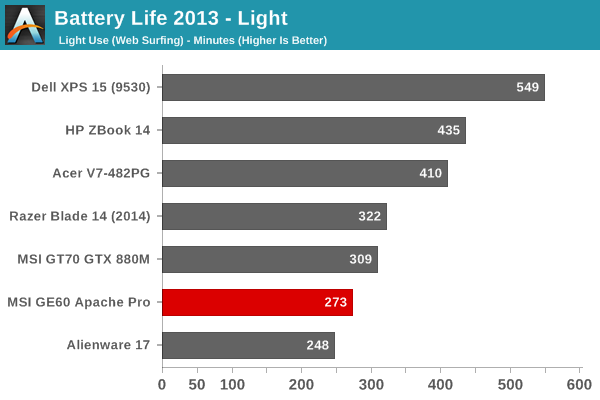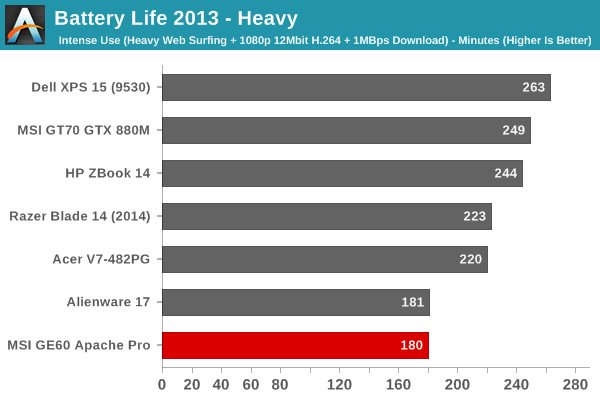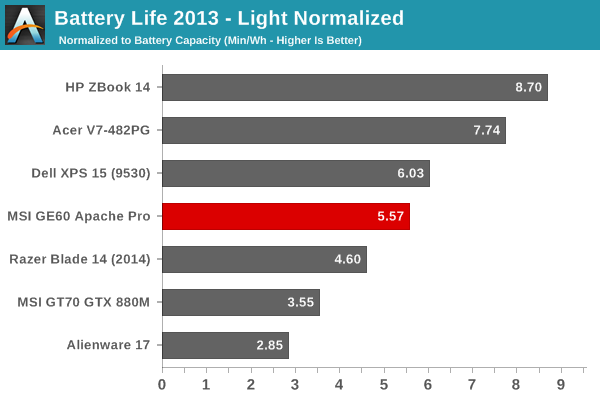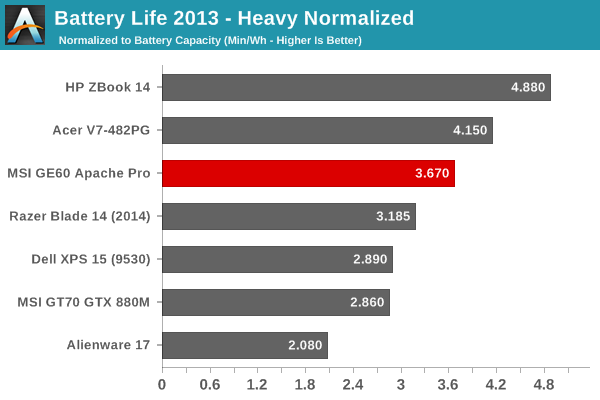MSI GE60 Review: Mainstream Mobile Maxwell
by Jarred Walton on July 17, 2014 5:00 AM ESTMSI GE60 Battery Life
As I mentioned earlier, battery life is the one area where the GE60 doesn't do so well. I wanted to spend some additional time investigating NVIDIA's Battery Boost technology, but with a relatively low starting point I'm not sure how much it can really help. Anyway, I'll get to that later. As usual, we have our Light and Heavy workloads.
One oddity is that the Heavy workload was consistently causing a BSOD with a VIDEO_SCHEDULER_INTERNAL_ERROR message after updating drivers. I'm not sure if the Intel or NVIDIA drivers are to blame, but I suspect it might be Intel's drivers as H.264 offloading tends to work just as well on Intel as on NVIDIA GPUs these days, so there wouldn't be much point in powering up the dGPU for video decoding. (Oddly, I haven't encountered this error on other laptops with Intel + NVIDIA solutions, so perhaps the problem is related to Maxwell and the specific workload we're running.)




The 49Wh battery isn't exactly large compared so other 15.6" laptops, but even so the battery life from the GE60 is pretty disappointing. Last year's GE40 managed to hit nearly nine hours with a 65Wh battery, so I was hoping to see at least more than six hours out of the GE60. I'm not sure if the root cause is BIOS/firmware related, or if some of the components (e.g. the LCD) simply consume a lot more power. Regardless, the GE60 manages 4.5 hours in our Light test and 3 hours in our Heavy test.
Power draw in the Light test looks to be around 10.75W (give or take), which isn't all that bad, but Dell's XPS 15 manages to support a QHD+ touchscreen LCD and still only consumes 9.9W in the same test, so there's definitely room for improvement. Dell also wisely chose to stuff in a 91Wh battery in their SSD-only XPS 15 model, which is nearly twice the capacity of the GE60's 49Wh battery. Things do improve a bit in the Heavy test, with the GE60 managing three hours compared to 4.38 hours – that means at a higher load the GE60 is drawing roughly 16.33W compared to the XPS 15 drawing 20.75W. And if you're curious about the current best result for power use, Sony's 13.3" VAIO Pro 13 only used 4.6W during the Light test and 11.4W in the Heavy test.
As for gaming battery life, without Battery Boost being enabled, you're looking at around 40-60 minutes, depending on the game and settings you're running. With Battery Boost, in some situations you might get close to two hours of gaming, but in most of my testing it looks like 60-75 minutes is a better estimate.










63 Comments
View All Comments
thesavvymage - Thursday, July 17, 2014 - link
in writing is not even always necessary, depending on local laws :) in Washington state, a verbal contract is a VALID contract. No need to write it and sign. There does need to be a third party to verify it thoughReedTFM - Friday, July 18, 2014 - link
For Americans, the Magnuson-Moss Warranty Act applies. Just modifying/servicing your product doesn't void a warranty guarantee, unless the producer can show the modification caused the defect. This came about because of car manufacturers were pulling crap like, "Oh look you added an aftermarket exhaust, you voided your warranty and we will not cover the windshield wipers failing."With static discharges, however, it will be hard to refute user error, but still, it's always worth making the argument.
ramj70 - Thursday, July 17, 2014 - link
I contacted MSI and they said that opening the laptop will to upgrade will not void the warranty. I also bought an SSD and replaced the HDDruthan - Thursday, July 17, 2014 - link
Without inbuild 3g modem.. so not for real life.Novaguy - Saturday, July 19, 2014 - link
There are phone plans that come with data tethering or wifi hotspot options, and I find those work well.Tanclearas - Thursday, July 17, 2014 - link
No DisplayPort and no G-Sync. This is exactly the class of machine that would benefit the most from it. Even if the claim is that it's too expensive to integrate into the laptop panel (though Nvidia themselves talked about how it's easier on laptops), DisplayPort would have at least allowed for the possibility of using an external G-Sync monitor.JarredWalton - Friday, July 18, 2014 - link
No, G-Sync is actually a pain in the butt on laptops, for one reason: Optimus. To do G-Sync, you need to have the GPU and display communicate with each other, so the only way NVIDIA can do it is if they get rid of Optimus. But doing that means you just killed battery life as well. There are potentially ways around that I'm sure, but it's the reason there haven't been any G-Sync notebooks yet. I actually asked NVIDIA about it at CES and they basically said as much: "We're looking at ways to implement it, but right now we don't have anything we can talk about."Tanclearas - Friday, July 18, 2014 - link
Wow. Interesting. Nvidia's response to AMD's "free sync" demo implied that laptops were easier to implement."However, Petersen quickly pointed out an important detail about AMD's "free sync" demo: it was conducted on laptop systems. Laptops, he explained, have a different display architecture than desktops, with a more direct interface between the GPU and the LCD panel, generally based on standards like LVDS or eDP (embedded DisplayPort). Desktop monitors use other interfaces, like HDMI and DisplayPort, and typically have a scaler chip situated in the path between the GPU and the panel. As a result, a feature like variable refresh is nearly impossible to implement on a desktop monitor as things now stand."
All of this just raises more questions.
In AMD's demo, did they have to disable DSG for free sync to work? If not, how does an AMD GPU communicate with the display? If so, then what AMD showed was even more impressive if Nvidia is still "looking at ways to implement it".
Are there laptops with free sync (officially) coming?
I am not trying to take things off topic. I just want to reiterate that the reviewed laptop is exactly the class of machine that would benefit the most from G-Sync/free sync. If anything, it is more important for a laptop because you do not ever have the option of replacing the GPU once your framerates start dropping.
One final (two-part) question. Could a laptop not have the DP connected directly to the Nvidia GPU? Is it not safe to assume that a person connected to an external DP monitor would have access to external power (and therefore not need Optimus)?
JarredWalton - Friday, July 18, 2014 - link
So basically on a laptop if you plug directly into the dGPU, yes, it's easier -- but I'm not sure how much easier we're really talking about. Obviously it can be done with desktop displays with enough effort, the main benefit of laptops being you have multiple inputs into desktop displays with scalers and such. An interesting corollary is that AMD might have an advantage with laptops using AMD APUs -- both the APU and dGPU would be AMD software, so there's no "Intel iGPU" in the way.As to the question of when laptops with G/Free Sync are coming, I don't believe any have been announced yet, so your guess is as good as mine. I told NVIDIA that laptops would be great for this as getting >60 FPS on a laptop is rather difficult but ~40 FPS with G-SYNC would still be achievable. We might see this in the next year, or perhaps even earlier with non-Optimus solutions (e.g. ASUS has the G750 without Optimus, so it might be a target for G-SYNC in an update). Of course, the number of displays with G-Sync support is still very small (one or two ASUS are officially available, another ASUS display can be modded by the user; Acer and BenQ have displays coming but they're not out yet.)
As for the second question: sure, an external G-Sync display could easily be driven by a laptop. But that sort of defeats the purpose of a laptop in large measure. :-)
Tanclearas - Saturday, July 19, 2014 - link
At first it might appear that it defeats the point of a laptop, but there is (what I assume a growing) group of aging gamers that require a laptop for business/work, but still want to game at home. I have a Lenovo Y580 with 16GB of RAM, a 240GB mSATA SSD, and the Nvidia GTX 660m. It's great for work, and OK for games, but would be better with G-Sync or free sync.